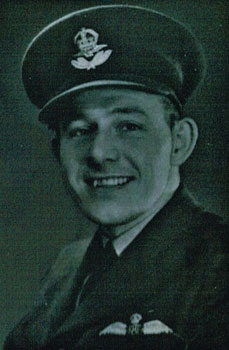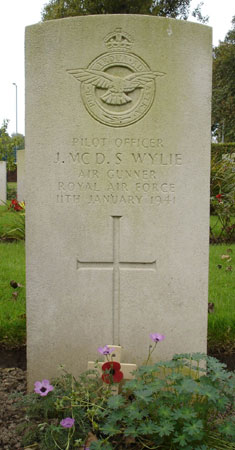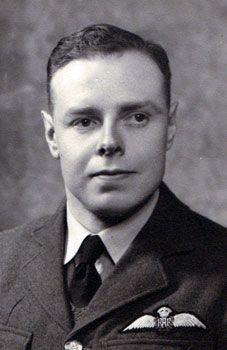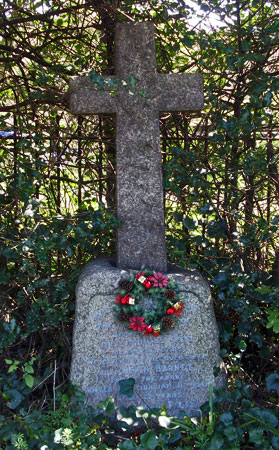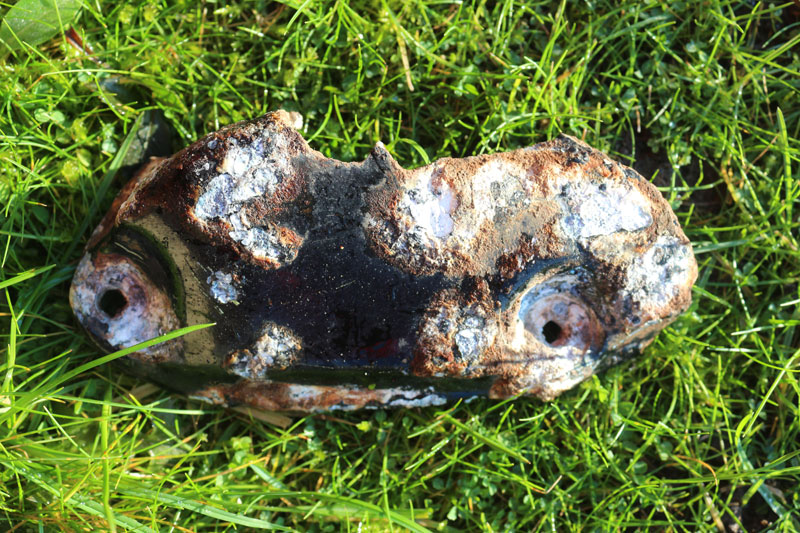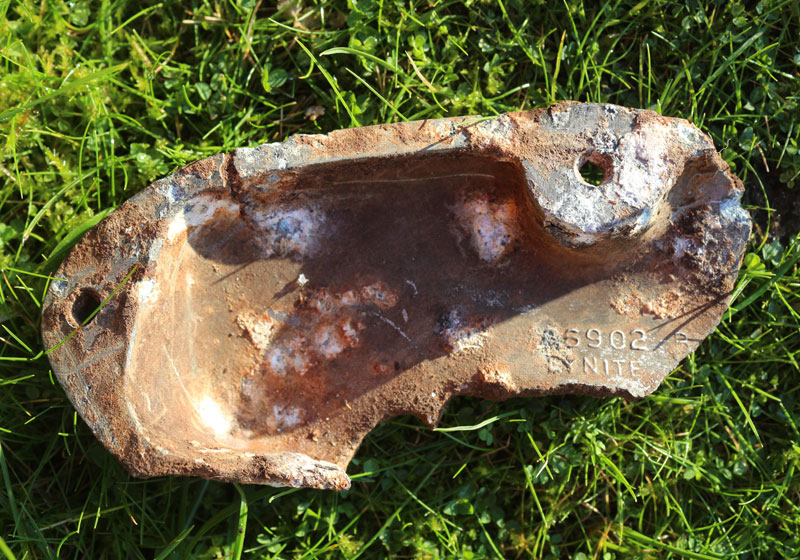
This photograph shows Hudson N7264 at Wick while in service with 224 Squadron. N7264 had also carried the 224 Squadron code "QX-Q" before eventually being replaced. Hudson N7298 was a later aircraft to carry the same squadron code.
The winter of 1940-41 was a very severe winter in the North of England with deep snow in the hills for many weeks. Very little is known about the circumstances surrounding this incident. The precise details of the flight are not fully known as the RAF's AM Form 78 accident card for the incident refers to the operation as being a "special task" and what this task was has not yet been learnt when the webpage was last updated. The 224 Squadron records do not list this Hudson as being flown on an operational flight on this date and the crew's AIR81 casualty file is missing from the National Archives' file series and this would give all the answers. What is known is that 224 Squadron Hudson N7298 took off from Leuchars, Scotland at 01.17hrs on 11th January 1941 and flew in a south-easterly direction out into the North Sea to undertake some form of night time operational flight. It has been suggested elsewhere that this crew had flown some fifty miles out into the North Sea from Leuchars looking for enemy vessels trying to cut through minefields. This is plausable. The AM Form 1180 states that the aircraft having initially flown south-east then turned on a northerly track possibly in an attempt to check navigation. The accident card then stated that it was thought that during the flight the wireless equipment and direction finding equipment might have failed (though this was then crossed out from the AM Form 1180). With the crew then were unsure of their position a likely scenario is that they then turned towards land; making landfall would allow the crew to work out where they were. Instead of then remaining along the coast the aircraft flew inland and struck high ground, on Warren Moor, just south of the village of Kildale. The exact time for the crash is not known. An earlier version of this webpage and other accounts of the incident suggested that Warren Moor was covered in snow at the time of the accident but in 2013 a witness to the incident stated at the memorial service that there was infact no snow present at the time but that the night was a stormy one and that the crew were flying in poor visibility. From plotting various items still at the crash site it appears to have been flying in nearly a North to South flight path at the time of the crash. If it had been flying on that course all the way from the coast it would have crossed the mouth of the River Tees and then head south, passing directly over Guisborough. I have found a basic police reference to this incident which states that the crashed aircraft was not located until 16.30hrs on 12th January 1941. Purely speculation on my part, was the "special task" that was referred to on the AM Form 1180 not of an operational nature but flying to Coastal Command airfield of Thornaby for an unknown reason. Here it would be worth adding that the 220 Squadron records give an indication of the weather at this time. 220 Squadron were based at Thornaby and would be the nearest RAF airfield to the crash site. They probably took charge of the site once it was found and recovered the bodies there. It states that on 10th January 1941 : "visibility poor, occasional fog, showers of slight rain, light breeze". 11th January 1941 : "visibility poor to moderate, much low cloud, frequent showers, gentle breeze". 12th January 1941 : "much low cloud, visibility poor to moderate, slight showers".
I have heard a second-hand account of the following but have yet to find any original source documentation to confirm it's truth. It appears to have now been taken to be as fact. All four of the crew are said to have survived the crash and although injured they either managed to scramble clear of the plane or were pulled clear by a lesser injured member of the crew. They probably later returned to wreckage after the danger of fire had passed to shelter from the weather. Sadly all four men had died before they could be rescued, they had all died probably through a combination of their injuries and of exposure before being found at 16.30hrs on 12th January 1941. Their bodies are said to have been found under a wing of the Hudson huddled together. Local recollection recounts that the owners of nearby Park Farm thought that they heard voices on that night but as the weather was so bad they did not venture out to investigate. The crew must surely have all been seriously injured, had they been able to explore their surroundings one would expect them to have found a drystone wall very close to the crash site and also the Kildale to Baysdale track, or farms just down from the moortop on the north side. Around 2007 I was been contacted by a local man, Mr Bell, who recalls his father was farm manager at Baysdale Abbey during the War. His father recounted to him seeing something odd on the moor while attending to sheep in the valley bottom. Upon exploring it became clear that it was an aircraft on the moor. This probably relates to this Hudson incident or possibly a Hampden that crashed south of Baysdale. He recalled that his father was one of the first to the crash site and that a good clean up job was done by the RAF in the weeks after the accident.
The 224 Squadron ORB has been obtained for January 1941 but it omits to include any reference to N7298's flight on 11th January 1941. The ORB does however list all the flights made by other 224 Squadron aircraft and crews in the search for the missing Hudson with six Hudsons undertaking flights; four in the late morning and two in the afternoon with only one of these later aircraft carrying out a search as far south as was needed. This aircraft searched the coast around Scarborough and Flamborough Head and upon landing the crew reported that the weather was too bad to go inland on their search so returned to base.
Hudson N7298 was built to contract 791587/38 by Lockheed-Vega at Burbank, California and was shipped to the UK, arriving in August 1939. It was then delivered from Liverpool Docks to the British Re-Assembly Division of Lockheed Ltd. at Speke, Liverpool. After assembly and testing at 6 M.U. it was issued to 224 Squadron at Leuchars in 2nd May 1940. It had an uneventful life until it suffered the above incident, being written off following a damage assessment of Cat.E2/FA following the crash on 11th January 1941. It was then struck off charge on 20th January 1941.
Pilot - P/O Basil Lincoln Fox RAF (42496), aged 26. Buried Brancaster Cemetery, Norfolk.
Pilot/Navigator - Sgt Keith Barnet Files RAF (523740), aged 27, of Worsley, Lancashire. Buried Worsley Churchyard, Lancashire.
Wireless Operator / Air Gunner - Sgt William Robert Martin RAF (520434), aged 25, of Netherfield, Nottinghamshire. Buried Thornaby on Tees Cemetery, Yorkshire.
Air Gunner - P/O John McDonald Scott Wylie RAF (43698), aged 21, of Edinburgh. Buried Thornaby on Tees Cemetery, Yorkshire.
On the 72nd anniversary of the crash a memorial plaque was dedicated close to the crash site with a good number of local people in attendance. The stone and the plaque were donated by the landowner, Andrew Sutcliffe and Kildale Parish Council chairman Malcolm Bisby organised the service with Rev. Haysmore officiating. I visited two days later and took these photographs.
I was unable to attend the memorial dedication but David Thompson kindly sent me some photographs of the ceremony shown here.
Basil "Peter" Fox's gravestone in Brancaster Cemetery, Norfolk. His parents were both British, his father Fred was born in Lincolnshire and his mother, Louisa (nee Loose) was from
Brancaster Staithe, Norfolk. By 1911 his father was living in Australia when his mother left England to join him and they were married in Australia in October 1911. Basil was born in
Granville, New South Wales on 21st August 1914 and he had an older brother called Geoffrey and younger sister called Jean. His uncle Pte Burton Pennant Loose was killed serving in WW1.
Basil joined the RAF and was granted a short service commission on 19th August 1939, being granted the rank of Acting P/O on probation and placed on the active service list for six
years. He was then graded as P/O on probation on 4th February 1940 and confirmed as P/O on 26th June 1940. His mother's sister was still living in the Brancaster area so requested
he be buried under her arrangements local to Brancaster. I thank Mr Basil McKinley for kindly contacting me and for supplying the photograph of Basil Fox shown above, his and the
Fox family were close before WW2 and who valued their friendship.
Sgt Martin's gravestone and a possible photograph of him (taken from an earlier 220 Squadron photograph).
He was the husband of Mrs Dorothy May Martin. Nothing more is known about his life or service.
Jack Wylie's gravestone at Thornaby Cemetery. He had joined the RAF at the very bottom; as an LAC on 2nd June 1940 he was granted a Short Service commission to the rank of P/O on Probation. I thank his nephew Mr Jack Ponton for the photograph of his uncle and the additional information he has kindly been able to provide this account.
Keith Files was born on 5th September 1913 to James and Ethel Files of Astley House, Boothstown and was baptised on 5th October 1913 in nearby St Mark's Church,
Worsley, Lancashire. His father was a colliery manager in the area, probably at the Astley Green pit. On the CWGC database his parents are listed as living in
Torquay, Devon when the CWGC made out their database in the years after the War - but this must only refer to his father as his mother had died in 1933. I thank
Mr Keith Files for kindly supplying the photograph of his cousin shown here.
Sgt Files and both his parents are buried in the same grave in Worsley Churchyard by the side of the M60 motorway, their gravestone is located under a large tree which blocked
out much of the light and hence the poor photographs of their grave which I visited in April 2014.
Warren Moor is the area shown above the fields behind the mining chimney and the aircraft struck the ground on the very top of the hill.
John Skinn and I finally located this crash site in December 2004 having visited the area many times searching for any sign of where the Hudson came down. By contacting others who had also tried to find the site it transpired that very little has ever been found at the site since at least 1980. The main leads to help me track down where my small finds were came via Howard Newbould and Jim Corbett, both had found tiny pieces in a similar area in the 1990s. John Skinn and I searched the same area and found on the surface the remains of just one .303 bullet case and a tiny corroded fragment of alluminium with a single rivet in place. In October 2020 I returned to the site again and owing to some extensive heather burning a few other small parts were seen on the surface. One of these parts was a Wright Cyclone engine rocker cover which I believe would be around the area the aircraft first struck the ground before running alone and coming to rest where our original finds were located.
My small fragments of the aircraft located in 2004.
A Wright Cyclone rocker cover with the associated text on the inside revealed after gentle cleaning.




